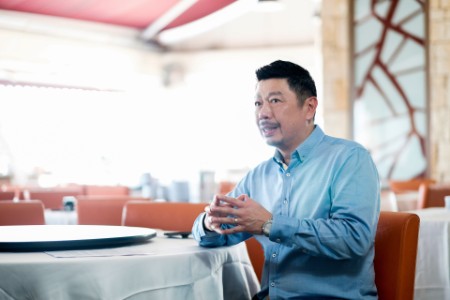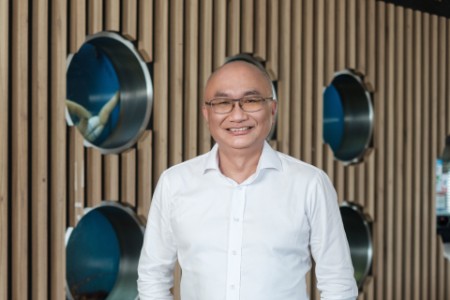
The better the question
How do you maintain your core values when scaling?
Kiam Meng and team realized they needed a renewed focus on both staff and customers to pave the way for global expansion.
It was a shared passion for socializing over great food that motivated Ang Kiam Meng’s father and nine friends to acquire a failing seafood restaurant from which JUMBO Seafood was created in 1987. It is now one of Singapore’s most popular restaurant chains, famous for its iconic chilli crab and black pepper crab.
The business quickly gained a loyal following. And as its reputation grew, so did the number of outlets. After Kiam Meng joined the family business in 1993, he continued with the expansion, overseeing the company’s IPO and initial foray into overseas ventures and franchises.
The transition from small business to listed multinational was both enormously exciting and challenging. Kiam Meng, Group CEO and Executive Director of JUMBO Group, explains, “As we grew from a small to medium-sized enterprise, we felt that the skill set in the organization and the knowledge that we have were not good enough to propel us further to be an international player.”
For Kiam Meng, the key questions were: how could they recruit a reliable labor supply to expand effectively? What could they do to motivate their workers to stay? And what skills and training would they need?
It was also crucial for Kiam Meng to remain faithful to JUMBO’s mission of “bonding people through food.” During a phase of high-pace growth, it can be challenging to focus on each individual customer. “We were lagging behind our goals of driving customer satisfaction and delighting our customers,” Kiam Meng says.
JUMBO CFO Tay Peng Huat agreed. “My main concern was, surprisingly, not financial, but the ability of JUMBO to overcome the challenges of expansion,” he said. He was immediately interested when he heard about the EY 7 Drivers of Growth from friend and former EY co-worker Choo Eng Chuan, Asean EY Private Leader.

The better the answer
A 7D perspective of what could be gained, and what must not be lost
Assessing JUMBO against the EY 7 Drivers of Growth helped Kiam Meng align his leadership and create a clear action plan.
Peng Huat attended the first 7 Drivers session with his financial controller, and both were impressed with how useful it was in terms of assessing JUMBO’s strengths and weaknesses. It helped them identify where to focus to achieve their ambitions for the business. He suggested that it would be helpful to bring in the rest of the C-suite.
During a second session, the management team realized that they had quite different perspectives on each of the 7 Drivers. Peng Huat observes that they had rarely made time to come together for this kind of open discussion. He adds, “It helped the team to think further and force us to look into areas which we might have neglected and better understand our position in the market.”
Importantly, the session helped them agree on the strategic goals for JUMBO and prioritize them. “With the organization’s goals aligned, we were able to build consensus and work toward our common goal,” says CEO Kiam Meng.
For the management team, the end targets were clarified. They would improve their HR function, especially staff development and talent management, and they would renew their focus on the customer.
With the organization’s goals aligned, we were able to build consensus and work toward our common goal.
From alignment to action
The next step was to explore how they would achieve their goals. Kiam Meng explains, “In the session, we recognized that the issues we faced could be resolved or improved with the implementation of a balanced scorecard and appraisal system. We also realized we could use our subsequent balanced scorecard to help address how we could be more responsive to customer needs and feedback as an organization.”
The scorecard became a way for each department to be fully aware of the company’s strategic goals and for employees to measure their performance. Kiam Meng says, “It has helped forge a clear and consistent sense of purpose.”
The management team also used the Key Initiatives Roadmap within the 7 Drivers framework to map out their priorities for the next three years. They can now document achievements and milestones as the company evolves.
JUMBO continues to build on its innovative programs to develop staff and keep them motivated and productive. The company now offers career progression in stages, with employees starting as waitstaff and then having the opportunity to progress to supervisory roles and restaurant management. JUMBO also provides staff with learning and development programs to upskill and improve their productivity.

The better the world works
A leader in the food and beverage sector
Investment in staff enables JUMBO to expand and fulfill its aim of bringing people together through food.
The impact of the 7 Drivers on employees has been positive and significant. CFO Peng Huat explains, “With the alignment of our organization’s goals at all levels, staff do feel a greater sense of belonging. We also hope that they feel more valued in our efforts in improving talent management.”
JUMBO’s investment in people has been noted: Singapore’s Prime Minister, Lee Hsien Loong, highlighted JUMBO Group as a role model in the food and beverage industry in his 2019 National Rally speech. He was impressed that the company positively promotes training and development and cares about employees’ welfare. Kiam Meng says, “We are extremely encouraged and believe that this will inspire more homegrown companies.”
Ultimately, trained and content staff enable JUMBO to better meet its customer’s needs and fulfill its core value of “bringing people together through food.” The company loves to see families and friends bonding over a meal and believes that kind of connection is one of life’s great joys.
Both Kiam Meng and Peng Huat agree that taking part in the 7 Drivers experience has left them energized and motivated to realize JUMBO’s ambition and bring Singaporean cuisine to a wider world.
However, one area where they agree to disagree, is which of their delicious crab dishes to choose. Kiam Meng insists on the black pepper crab, whereas Peng Huat’s firm favorite is the chilli crab. Both dishes are so popular that JUMBO serves around 1.9 tonnes of them a day to around 9,000 diners, a number set to increase as they use the 7 Drivers to bring their cuisine to a global clientele.
This case study was co-authored with former EY Partner Eng Chuan Choo.



